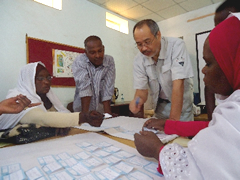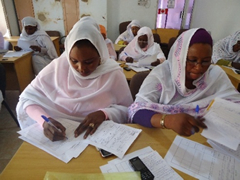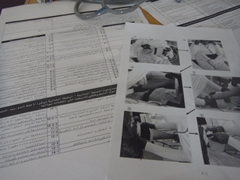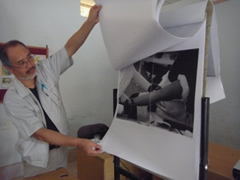- Home
- Technical Cooperation Projects
- Index of Countries
- Africa
- Sudan
- Capacity Development Project for Provision of the Services for Basic Human Needs in Kassala
- Project News
- Training of Facilitators: Toward Effective Coaching for Village Midwives
Project News
2012-07-12
Training of Facilitators: Toward Effective Coaching for Village Midwives
 Students conducted an analysis of required abilities of VMWs by using CUDBUS method with the advice from Mr. Kume.
Students conducted an analysis of required abilities of VMWs by using CUDBUS method with the advice from Mr. Kume.
From July 1st to 12nd,2012, Health Cluster in corporation with Vocational Training Cluster provided 10 days coaching workshop for 11 health visitors in Kassala who perform as facilitators in In-Service Training for Village Midwives(VMWs).In Kassala, about 85 % of deliveries occurred at home and both maternal mortality rate and neonatal mortality rate are high. The formerrate was found to be 244.9 per 100,000 live births (2010) and the latter one was 31/1,000 live births (2006)in Kassala. Thus, to strengthen maternal and child health is crucial issue so that developing the capacity of frontline staff for those area is one of our activities in Capacity Development Project for Provision of the Services for Basic Human Needs in Kassala (K-TOP). Especially, for decreasing maternal death rate, it is very important to discover high-risk group or dangerous sign in early stage and conduct proper prevention, early care and treatment.
 After learning microteaching, students made their own lesson plans. Each of them did a presentation and assessment.
After learning microteaching, students made their own lesson plans. Each of them did a presentation and assessment.
K-TOP has supported for implementing an in-service training for VMWs who play a significant role in reduction of maternal mortality. In the in-service training, health visitors become as facilitators. They are consisted of supervisors of VMWs in community and teachers of the Midwifery Schools in Kassala, Aroma and New Halfa. Although the health cluster has worked to improve the quality of the training, to enhance the coaching method of facilitators has been one of the challenges to be addressed. The VMWs trainings by facilitators were composed of lectures and practices based on one-sided dictation and, as a consequence, they were not learner-centered. Particularly, since most of the VMWs cannot read or write a word, it was necessary to have an effective training for illiterates.
 The left one is the Job Sheet for literate persons which indicates step, key point and why of the blood-pressure measurement procedures. The right one is the Job Sheet for illiterate persons which shows the procedures by using photos.
The left one is the Job Sheet for literate persons which indicates step, key point and why of the blood-pressure measurement procedures. The right one is the Job Sheet for illiterate persons which shows the procedures by using photos.
For this need of training on coaching for facilitators, the health cluster organized a workshop in corporation with Mr. Atsunori Kume, a Japanese Expert in Vocational Training Cluster who has a rich experience of training on coaching methods for trainers. In the workshop, at first, students were divided in small groups and conducted an analysis of required abilities (technique, knowledge and preferable behavior) of the VMWs and discussed the priority among them. After the discussion, students made Job Sheeton blood-pressure measurement, urine test and neonatal resuscitation. On one hand, the Job Sheets for literate persons described1) Step, 2) Key Point and 3) Why, on the other hand, those for illiterates showed photos of each step. It aimed to make easier to review the procedures by dividing in steps and to remember important procedures correctly with strong impression by indicating clear key points and the reasons for doing them.
 Text for illiterate persons (picture story) made by putting photos of 12 steps of blood-pressure measurement procedures. Photos are from the video taken last day student's demonstration.
Text for illiterate persons (picture story) made by putting photos of 12 steps of blood-pressure measurement procedures. Photos are from the video taken last day student's demonstration.
At the last two days of the workshop, there was a practice of coaching based on the Job Sheet. Coaching has four steps, introduction, presentation, practical training and summary. Concerning the second step, presentation, a facilitator repeats a demonstration for three times in different ways. 1) Demonstrate promptly and well without explaining in order to make students grasp the whole picture of work and make them motivated. 2) Demonstrate the same procedures with saying the name of the step written on the Job Sheet. It is important to emphasize the numbers of steps, for example, by telling "this work is consisted of 8 steps". This has an effect for illiterate to make the impact for remembering procedures. 3) Demonstrate by explaining steps and key points in detail.
Ms. Shadia, one of the students in the training, said that, at the first two days, she thought Mr. Kume knew nothing about health and came here for studying it because he repeated a lot of "Why". "However, from the middle of the training, I realized I was learning a new method of coaching. I would like to be able to do this way of facilitation (learner-centered facilitation)", she shyly said. Moreover, Ms. Nafeesa, one of the students who will be an assistant facilitator soon, told her objective is to be a facilitator who can make trainees to learn each procedure in correct manner.
Related Link
- About JICA
- News & Features
- Countries & Regions
- Our Work
- Thematic Issues
- Types of Assistance
- Partnerships with Other Development Partners
- Climate Change / Environmental and Social Considerations
- Evaluations
- Compliance and Anti-corruption
- Science and Technology Cooperation on Global Issues
- Research
- JICA Development Studies Program / JICA Chair
- Support for the Acceptance of Foreign HRs / Multicultural and Inclusive Community
- Publications
- Investor Relations
